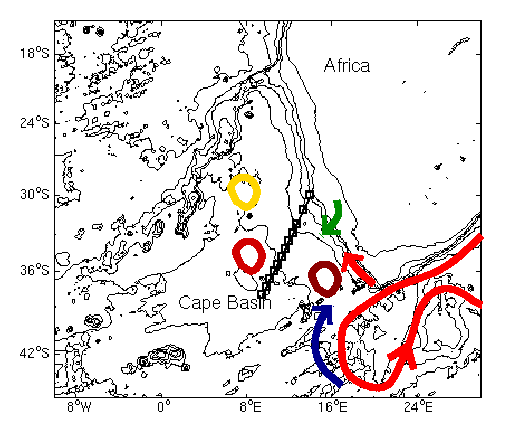Strong evaporation, cooling and mixing can further modify the water mass
properties, enhancing the signature of South Indian Subtropical Mode Water
(STMW) [Olson et al., 1992]. Three rings in the process of
cooling, mixing and propagating into the South Atlantic Ocean are
sketched in red-orange in the figure above.
Anticyclonic rings with a distinctly different core of
Subantarctic Mode Water (SAMW) have been observed on several occasions.
While indistinguishable from warm Agulhas rings on the basis
of their sea level signature, SAMW rings carry a thermohaline
signature completely unlike the typical warm Agulhas ring.
SAMW rings probably also originate in the Agulhas Retroflection
while the water at their cores comes from ~60E in the
Indian Ocean [McDonagh and Heywood, 1999].
Retroflection and ring formation processes can also inject
Subantarctic Surface Water (SASW) and the relatively colder and
fresher Antarctic Intermediate Water (AAIW) into the region [Shannon
and Hunter, 1988]. This process is represented by the blue arc above.
Warm filaments entering the Cape Basin inshore of the
Agulhas Current have been observed [Lutjeharms and Cooper, 1996].
The short red line symbolizes these mesoscale features.
Lastly, in the Benguela upwelling regime near the African coast, Atlantic
surface waters (SSW) are replaced by warmed and upwelled water from
further down in the water column [Stander 1964; Shannon 1966].
Filaments and eddies of upwelled water are advected
to the west and have been detected 700 km from the coast. This water then
mixes into the South Atlantic [Lutjeharms and Stockton, 1987]. This
process is represented by the green curve in the figure above.
Our principal interest is to measure the contributions of the larger
features of Indian Ocean origin to the thermohaline balance of the South
Atlantic. The ASTTEX array will span the trajectories of over 90% of Agulhas
rings that have been tracked from the Retroflection [e.g., Byrne et al., 1995; Witter
and Gordon, 1999, Goni et al, 1997, O. Boebel, pers. comm.] plus the observed
location of the Benguela Current [Garzoli and Gordon, 1996; Garzoli et al, 1996].
We estimate up to 1/2 of the inter-ocean
transport may be accomplished by mesoscale features (e.g., rings, eddies,
filaments) [Byrne, 2000]. ASTTEX also contains a retrospective component,
which is the main subject this work.
